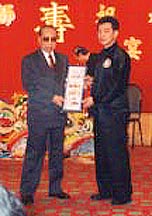| Kwong Tit Fu began his Hung Gar training in Guangzhau under his uncle, Kwong Chong Sau. He learned several systems, and to further his knowledge, he sought out Lam Cho in Hong Kong. He later emigrated from Hong Kong to the United States. In 1971, shortly after Kwong Tit-Fu’s arrival, Calvin Chin secured him as a Kung Fu instructor for a youth athletic club where he was a martial arts instructor. He assisted his new teacher in establishing the first Hung Gar Tiger Crane school on the East Coast. After many years of extensive research and development, Kwong Tit Fu founded his own system, Fu Hok Tai He Morn. This system is a synthesis of the methods and principles of Hung Gar Fu Hok kung fu, Wu style tai chi and Mu Dong – Yat Hei Ngm Hahng Morn, an advanced level internal system. After receiving a black belt in the Uechi Ryu Karate system, Calvin Chin wanted to further his knowledge by studying a traditional Chinese system. He tried several different systems before he heard of Kwong Tit-Fu’s martial arts prowess. Calvin Chin was president of his teacher’s school, and its chief instructor. Today, he remains the top disciple of the Fu Hok Tai He Morn system and continues the tradition at his own school.
For more information about our kung fu lineage visit www.hungkuen.com |
| This southern Chinese kung fu style incorporates both external and internal methods. Hung Gar emphasizes strong stances, long and short hand techniques, which encompasses straight, circular, and angular movements. The intent is to develop efficiency of movement, as well as coordination. This result in superior inside maneuvers, none more evident than the variation of kicks, mostly executed below the waist. Although the execution of movement appears to be hard, this system, in fact, incorporates both hard and soft techniques in a multitude of directions. The execution of advanced techniques is complex. Research has determined that Hung Gar possesses more intricate hand techniques and stance maneuvers than any other traditional system from China. Because it is also an internal system, it can boasts many health benefits. |


